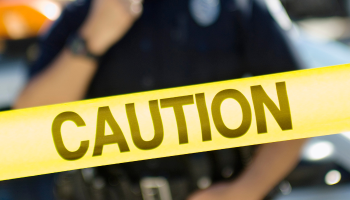There’s an open secret about seat belts at police departments. Many officers killed in line-of-duty car crashes aren’t wearing them.
Dozens of officers across the country have died in crashes while not wearing seat belts in recent years — at least 64 between 2004 and 2008 alone, according to National Highway Traffic Safety Administration data analyzed for the Houston Chronicle. About 40 percent of officers killed in wrecks during that time period weren’t buckled up, the analysis showed.
In Texas, the numbers are similarly stark. Five of the 13 officers killed statewide since 2007 in car crashes while on duty have been unbuckled, the Chronicle found after reviewing Texas Department of Transportation crash reports. The most recent unbuckled officer traffic fatality in Texas was in Burnet County last October. Frank Cantu, killed in a 2004 wreck while unbuckled, was the last member of the Houston Police Department to die in a crash.
It’s impossible to know how many of those officers could have been saved if they had buckled up, although one study says officers were nearly three times more likely to die in car crashes with their belts off.
But officers and administrators say police culture can sometimes discourage their use.
Some officers worry that their belts could hinder them if they have to exit quickly to confront a suspect — a seat belt can easily get tangled on a holster. Others fret they’ll be unable to control violent prisoners while buckled up.
Tough to spot trends
Police-related Internet forums offer tricks for disabling seat belt alarms and for avoiding supervisors who monitor belt usage by officers on patrol.
“The average police officer thinks most cops get killed by felons, and that’s not true. Cops are getting killed in traffic accidents,” said Richard Ashton, who studies traffic safety for the International Association of Chiefs of Police. “Officers don’t think it can happen to them.”
During the past three years, 16 Texas police officers were shot to death, but 18 died in car and motorcycle crashes.
Little research has been done on seat belt use by police officers, making it tough to spot trends or determine how widespread problems are. The limited data comes from sources ranging from the National Highway Traffic Safety Administration, to an informal study based on the television show COPS, to statistics kept by police departments.
Little research has been done on seat belt use by police officers, making it tough to spot trends or determine how widespread problems are. The limited data comes from sources ranging from the National Highway Traffic Safety Administration, to an informal study based on the television show COPS, to statistics kept by police departments.
How many officers wear seat belts consistently? A 2006 study in the Journal of Trauma: Injury, Infection and Critical Care analyzed the syndicated COPS series and found officers buckling up less than 40 percent of the time. A 2005 study in the Journal of Trauma found about 20 percent of officers who died in crashes between 1997 and 2001 weren’t wearing seat belts. Ashton’s estimate is that up to a third of officers fail to buckle up.
“The problem is widespread,” the former chief of police said.
Some states have exemptions that allow police officers to remove their belts in emergency circumstances. But in Texas, where police are supposed to follow the same seat belt laws as the public, officers say the decision to buckle up isn’t as simple as it might appear.
Trained and reminded
“Every situation is different. You may have to jump out of the car quickly — there are times when we have that mindset,” said A.J. Gonzales, a patrol sergeant based at the HPD’s South Central patrol station. “We’re supposed to wear it, but if you’re running hot somewhere you have to be fast on your feet.”
HPD officials emphasize seat belt use during recruit training and send out periodic memos to remind officers of that responsibility.
“We expect our divisional commanders to remind our officers to be safe. And we’ve got an accident review board that looks at those things,” said Executive Assistant Chief Martha Montalvo.
“At some point, the officer has to make those right decisions,” Montalvo said. “I’m a firm believer the majority of officers are.”
The Harris County Sheriff’s Office reported 18 of its officers were unbuckled in 392 officer-involved crashes last year.
But HPD reported all of its officers wore seat belts in the 752 crashes they had last year.
Officers self-report whether they were buckled up when involved in a car crash, and authorities have no evidence of underreporting, Montalvo said.
Speed also a factor
One challenge to seat belt use is complacency.
“I think you become desensitized to the fact that, ‘Hey, we are driving a 2,000-pound vehicle,’” said Tom Gaylor, a reserve officer with the Colorado County Sheriff’s Office and a spokesman for the Texas Municipal Police Association.
Sometimes, however, tragedy forces officers to re-evaluate.
In Corpus Christi, the January 2008 death of 25-year-old officer Matthew Thebeau prompted officials to clamp down on officers who wouldn’t buckle up or were driving too fast.
Thebeau was en route to a call and driving 107 mph on Texas 286 when he lost control and hit a concrete barrier. The officer, who wasn’t buckled up, was ejected onto the road and run over by a car.
Almost all Corpus Christi officers now wear belts, said department Capt. Todd Green, describing a campaign to strictly enforce seat belt regulations and reforms that included setting up GPS units to e-mail alerts to supervisors when officers drive too fast.
“The combination of both re-emphasizing seat belt use and the nature of what happened in this crash — I think those two things combined are leading to more compliance,” said Green, who remembers one of his training officers encouraging trainees never to buckle up.
More recently, the deaths of two unbuckled officers in the span of a few months last year prompted the Las Vegas Police Department in Nevada to threaten officers with traffic citations if they are spotted driving without their seat belts secured.
“We will comply with the law. Everyone in law enforcement knows that seat belts make a difference in a wreck,” said Jay Rivera, a department spokesman.
Emphasizing the power of public perception could also make a difference. How can officers write tickets for seat belt violations if they’re not buckled up themselves?
“You can’t uphold the law if you’re not wearing them,” said Houston Police officer Joe Sanchez, who said he always wears a seat belt.
Other measures to address the problem, experts say, include increased training on the importance of seat belts and how to get out of them quickly.
New technology could also dispel officers’ fears about getting stuck in their belts. Dietrich von Kuenssberg Jehle, an author of the 2005 Journal of Trauma study, suggests a belt that would automatically release each time a cruiser is put in park.
‘You always wonder’
The pain of an officer’s death in a car crash is long-lasting for friends and family members. There’s often no one to blame and only lingering, unanswered questions.
Marie Pyevach felt that emptiness after the death of her son, HPD officer Frank Cantu, six years ago. Cantu told his mother he didn’t buckle up because the seat belt made it harder to jump out and confront suspects.
“He said, ‘I need to be ready, I have to be ready,’ ” Pyevach remembered.
In Corpus Christi, Matthew Thebeau’s family members still ask themselves why the man who had long dreamed of being a police officer wasn’t buckled up on the night he died.
“Of course you think about it,” said Martin Thebeau, the officer’s uncle. “You always wonder why he didn’t have a seat belt on. I don’t know, I just don’t know.”













